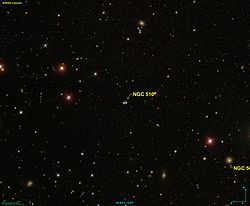| Observation data Epoch J2000.0 Equinox J2000.0 | |
|---|---|
| Constellation | Pisces |
| Right ascension | 01h 23m 55.56s [1] |
| Declination | 33° 29′ 48.80″ [1] |
| Apparent magnitude (V) | 14.9 and 15.1 [2] |
| Other designations | |
| GC 5173 | |
NGC 510 is a double star in the constellation of Pisces. [2] [3] The stars are separated 8", and located 7' ESE of NGC 499 and 9' WNW of NGC 515. [4]
